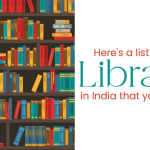Are you looking for best Digital libraries in India? In a world that is rapidly becoming digitalized, a digital library is a treasure trove of knowledge that can be accessed and used by anyone with an internet connection. Imagine having a vast collection of books, journals, articles, images, and videos at your fingertips, all available online, and just a click away!
Digital libraries have made it possible to access information and resources from anywhere, at any time, and at a fraction of the cost of physical libraries. They are a game-changer, offering users the ability to search for specific materials, refine their search using advanced search capabilities, and bookmark and highlight important information.
But digital libraries are more than just a collection of materials. They offer users the ability to collaborate and connect with others who share similar interests, creating a community of learners and researchers. With features like note-taking and citation tools, users can organize their research and share it with others.
In today’s fast-paced world, digital libraries have become an essential resource for learning, research, and exploration. They have revolutionized the way we access and use information, and have opened up a world of possibilities for those seeking knowledge and understanding.
Here is a list of 10 best digital libraries in India for you to surf around –
The National Digital Library of India (NDLI) is a project initiated by the Ministry of Human Resource Development, Government of India, to provide free access to digital educational resources for all citizens.
It aims to develop a comprehensive digital library that can be accessed from anywhere in the world. The NDLI provides open access to a variety of content such as books, journals, manuscripts, audio-visual materials and more.
This library is designed specifically for students and teachers with an easy-to-use interface and powerful search capabilities. It also offers various tools such as online quizzes, discussion forums and learning management systems which help facilitate learning.
The NDLI is currently available in seven Indian languages – English, Hindi, Tamil, Telugu, Malayalam Kannada and Gujarati – making it accessible to millions of students across the country.
The Digital Library of India (DLI) is a project initiated by the Ministry of Human Resource Development, Government of India, to provide free access to digital resources. It is an online platform that provides access to digital books, manuscripts, and images from various cultural heritage institutions across the country.
The DLI has established partnerships with several institutions in order to digitize and preserve cultural heritage materials such as rare manuscripts and ancient texts. It also makes these materials available for research purposes as well as for public use.
The DLI provides an easy-to-use interface with powerful search capabilities which make it easy for users to find the information they need quickly and easily. It also offers a range of tools such as online quizzes and discussion forums that can help facilitate learning.
You may also read: Query Letter vs. Cover Letter: What’s the Difference?
The British Library and institutions in India collaborated on the British Library Endangered Archives Programme (BEAP) to digitise and conserve at-risk materials. The programme collaborates with Indian archive institutions to digitise manuscripts, photos, recordings, and other research-critical artefacts that are in danger of being lost owing to abuse or damage.
The BEAP offers financial support for initiatives that assist in digitising endangered archives and making them accessible online via its website.
This gives academics from all around the world simple access to these priceless resources and protects them for upcoming generations. The BEAP also collaborates with regional groups to educate people about their cultural history and how to preserve it.
You may also like: How to Become a Writer: A Step-by-Step Guide for Authors
JSTOR is a widely known digital library that provides access to a vast array of scholarly content, including books, journals, and primary sources. The library is a not-for-profit organization that was founded in 1995 to help support academic research and teaching.
It has partnerships with several institutions in India, including the Indian Council of Historical Research, the Indian Academy of Sciences, and the Indian Institute of Science Education and Research. These partnerships allow JSTOR to offer local content and make it accessible to researchers and scholars in India.
JSTOR’s collection includes more than 12 million academic articles, books, and primary sources, covering a broad range of subjects such as humanities, social sciences, and sciences.
The platform is designed to support academic research and provides a powerful search engine that enables users to find relevant articles and materials quickly. JSTOR also provides tools for researchers to analyze and manage their research, including citation tracking, bibliographic management, and the ability to save and share articles.
The library is available to individuals and institutions, and its content is accessible through subscription or pay-per-view. JSTOR offers a variety of subscription options for academic institutions, including access to specific subject collections or the entire JSTOR archive.
Individual researchers can also subscribe to JSTOR on a monthly or annual basis. JSTOR also offers a program for people who cannot afford access to its content called the Register & Read program, which allows users to read a limited number of articles online for free each month.
You may also like: Tea, Rain & Self-Publishing: A Guide to UK Authors
Open Library is a non-profit digital library that aims to provide free and open access to millions of books. The library operates as a project of the Internet Archive, a non-profit digital library with a mission to provide universal access to all knowledge.
Open Library relies on a network of volunteers who help to digitize and upload books to the platform.
Users can search for books by author, title, or subject, and can also browse curated collections, such as the “Classics” or “Science Fiction” collections. Once a book is found, it can be borrowed for a period of two weeks. The library also offers a feature to create a personalized digital bookshelf, where users can save and organize their favorite titles.
In addition to offering free access to ebooks, Open Library also has a physical book lending program, where users can borrow books from participating libraries. The platform also provides APIs for developers to access and use the library’s data, making it a valuable resource for researchers, educators, and developers.
Overall, Open Library is a great resource for anyone looking to access and read books online, completely for free.
You may also like: How to Become a Writer: A Step-by-Step Guide for Authors
The Internet Archive is a non-profit digital library that aims to provide universal access to knowledge. It was founded in 1996 by Brewster Kahle and is based in San Francisco, California. The archive’s mission is to preserve cultural artifacts and provide open access to digital content, including books, movies, music, and websites.
The library has a vast collection of over 70 petabytes of digital content, including over 40 million books and texts, 5 million audio recordings, 4 million videos, and 5 billion archived web pages. The content is available for free to the public, and the archive’s digitization efforts are supported by donations from individuals, institutions, and governments.
The Internet Archive’s Wayback Machine is a particularly notable feature, allowing users to view archived versions of websites dating back to the mid-1990s. The Wayback Machine is an essential tool for researchers, journalists, and anyone interested in tracking the evolution of the web.
The archive relies on a network of volunteers to digitize and upload content, and it encourages users to contribute their own materials to the collection. The Internet Archive is an invaluable resource for researchers, students, and anyone interested in accessing and preserving digital content.
The National Repository of Open Educational Resources (NROER) is an initiative of the Government of India’s Ministry of Education. It was launched in 2013 to provide free and open access to high-quality educational resources to learners, teachers, and anyone who is interested in learning.
The NROER offers a vast collection of digital educational resources, including textbooks, audio, video, images, and interactive simulations. The library covers a wide range of subjects, from math and science to social sciences and languages.
The NROER’s resources are available in multiple languages, including English, Hindi, and several other Indian languages. The library is accessible to anyone with an internet connection, and users can browse the resources by subject, grade level, and language.
The NROER’s goal is to promote the use of open educational resources and encourage teachers and learners to use these resources in their teaching and learning practices.
The initiative aims to improve the quality of education in India by providing free access to high-quality educational resources that are aligned with the Indian curriculum.
In the age of digitization, the way we access and use information has undergone a significant transformation, and digital libraries have emerged as an essential and valuable resource. With lightning-fast internet connectivity and advanced technology, accessing and retrieving information has become much more convenient than ever before.
The list of 10 Best Digital Libraries in India is a clear indication of the country’s growing commitment to providing its citizens with access to an extensive collection of digital resources. These libraries offer a broad range of materials that can be accessed from anywhere and anytime, ranging from books and journals to images, videos, and other types of content.
Publish your book for free with BlueRoseONE and become a bestselling author. Don’t let your dream of becoming an author fade away, grab the opportunity now and publish your book – be it fiction, non fiction, poetry or more.
Till Then Happy Reading!
















